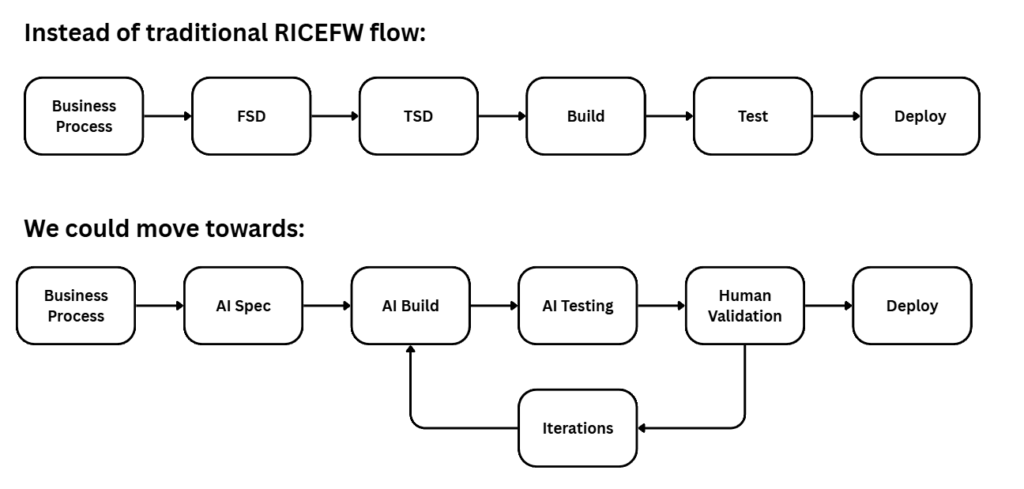Custom development in the SAP ecosystem, whether its ABAP based RICEFWs or extensions on SAP BTP, has always been a complex machine, layered with functional specs, technical specs, long validation cycles, and many late-night debugging marathons. But just like AI has flipped traditional software development on its head, it’s only a matter of time before it fundamentally reshapes how we build custom solutions in the SAP world.
And not just incrementally — we’re talking about a step-function shift.
Why SAP Custom Development Is Ripe for Disruption
SAP development is deeply structured around RICEFW objects (Reports, Interfaces, Conversions, Enhancements, Forms, Workflows) and more recently, BTP-native development using RAP and CAP. These objects follow a rigid SDLC:
- Business process mapped in Fit-Gap or FSD sessions
- Technical & Architecture design documented in TSDs
- Development done in ABAP, RAP or Node.js/Java on BTP
- Multiple rounds of testing by developers, functional consultants and end users
- Deployment, transports across landscape and subsequent go-live
This waterfall flow means long cycles, unclear handoffs, and tons of time lost in translating what the business wants into what actually gets built.
But here’s the catch: a large majority of what we build is based on prior patterns. Think of all the sales order enhancements, stock transfer custom forms, or approval workflows we’ve built. They follow similar logic with minor business-specific variations.
This is where AI steps in.
AI’s Playbook: What’s Already Happening Elsewhere
Look at how AI has disrupted traditional coding:
- Replit’s Ghostwriter generates full-stack apps from prompts.
- Cursor lets developers have natural conversations with their codebase.
- Windsurf converts internal business app requests directly into deployable apps.
- Qodo eliminates the need to even write code — everything is prompt-driven.
These tools are reinventing software development — going from weeks to hours.
Now imagine bringing that disruption into the SAP space.
A New SAP SDLC: From Human Docs to AI-First Specs

Real-Life Possibility:
A business user describes:
“I want a responsive app that allows quality inspectors to log defects across production lines and plants as well as corporate to report across geographies, items and plans”
Today:
- Business explains and documents business process and pain points
- Consultant documents in Functional Specification document
- Developer writes a technical specification with an architecture and integration expectations
- Build and unit testing takes 3-5 weeks
- User sees app during UAT
Tomorrow:
- AI ingests prompt
- Suggests UI wireframe + logic based on past templates
- Generates CAP or RAP code with test cases
- Deploys preview version in 30 mins
- User validates and iterates
Where the Disruption Is Most Likely
- RICEFW remediation and modernization
- Custom Reports & Enhancements: Generate dynamic CDS views and Fiori Elements screens with natural language
- Forms & Workflows: Auto-generate using AI templates based on intent and industry
- Integrations: Use prompt-driven iFlow generation on CPI or BTP Event Mesh
- Testing: AI-generated test scripts + automated unit testing
- Spec Writing: Structured spec generation from business conversations
This is more than Copilot-level productivity. This is “skip-the-line” acceleration.
What We Need: SAP-Native AI Startups
This is a golden opportunity for startups who understand the SAP stack — not just AI. We don’t need to integrate ABAP into Cursor or Replit. We need:
- Agents that can perform fit to standard analysis and help map RTM and technical debt to standard SAP functionality
- Agents trained on SAP objects (RICEFW, CDS, Fiori, OData) that generate new RICEFWs or convert legacy RICEFWs to modern Clean Core version
- Agents that build Custom CAP or RAP applications in weeks with live iterations as business users test
- Agents that explain legacy code, document it and propose architecture design patterns and alternatives
- Automated test data generation, test cases creation and automated testing
- Workflows that understand transport requests, SAP landscapes, CTS, QA gates
- Developers who can leverage state of the art AI tools to document end to end process flows, develop applications, iterate and ship in days, not even weeks or months
There’s a $100B+ services market ripe for optimization.
Final Thoughts: From Legacy to Lift-Off
In 2025, building SAP apps should feel like prototyping in Figma — fast, iterative, human-friendly — but powered by AI agents behind the scenes.
We’ll still need domain and business process knowledge. We’ll still need governance. But what we won’t need is several months to ship an enterprise grade custom business apps or enhancements.
This transformation won’t come from SAP alone. It’ll come from a mix of smart startups, open-source contributors, AI industry and forward-thinking SAP teams.
If you’re exploring how to modernize your SAP custom development or rethink your SDLC for an AI-first world, let’s connect. I help enterprises unlock real savings in time, cost, and quality by optimizing their SAP development lifecycle using AI and automation.
